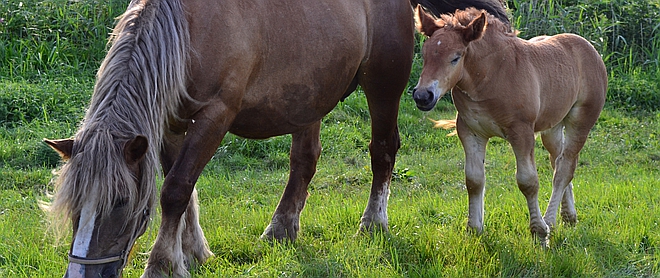MONITORING OF A PREGNANCY IN A MARE
by
Reis ÖZMEN,Erasmus Student,2014
Uludag Unıversıty,Turkey
NON-CHEMİCAL METHODS
Behavioural changes;
-The mare’s behaviour towards a stallion can be a good indicator. From about 14 days after serving, a pregnant mare should reject a stallion’s advances. That is they will not display the characteristic behaviour, which includes welcoming his advances and “showing” their rear.
-If a mare does not begin her oestrus cycle within 21 days of being served, it can be assumed she is pregnant.
Transrectal palpation;
-in the rectum and feels the uterus for signs of pregnancy. These include uterine tone, the shape of the uterus, and the presence and size of the small sac containing the foetus, called the amnionic vesicle.
Ultrasound examination;
- Protocol (When Ovulation Time is Known)
-First exam Day 14 to 15
-Second exam Day 24 to 27
-Third exam Day 33 to 35
-Autumn exam October
(day of ovulation is Day 0)
A rectal exam checks the tightness of the cervix, the position of the foal, the size of the uterus, and movement of the fetus.
All embryos should be detectable by day 24. By day 24 of pregnancy, the embryo is approximately 6 mm in length. The heartbeat can normally be detected as a flickering movement in the middle of the echoic embryo around this stage of pregnancy.
Pregnancy diagnosis by ultrasound may initially be performed 12 to 18 days after ovulation.
By day 16 of pregnancy the vesicle is normally fixed at the base of either the left or the right horn.The shape is still regular, but more ovoid than strictly spherical.
By day 45, the foetus has descended approximately two-thirds of the way towards the ventral part of the allantois. The developing head of the foetus is recognisable.
CHEMİCAL METHODS
Pregnancy testing by measuring PMSG(pregnant mare serum gonadotrophin);
This is best performed between 40 and 100 days after breeding. PMSG is a protein produced by the endometrial cups – a group of cells from the embryo that temporarily colonise the lining of the mare’s uterus.
Oestrone sulphate;
-is produced by the foetal-placental unit, and measuring its blood concentration is a well-established, reliable and accurate method for pregnancy-testing mares from 100 days post-breeding right through to the expected time of foaling
VACCİNATİONS
-Mares are given vaccinations against diseases such as the Rhinopneumonitis (EHV-1) virus (which can cause abortions) as well as vaccines for other conditions that may occur in a given region of the world. Pre-foaling vaccines are recommended 4–6 weeks prior to foaling to maximize the immunoglobulin content of the colostrum in the first milk.
-the mare should be receive; tetanus toxoid, equine influenza, and Eastern/Western encephalomyelitis.
DEWORMING
-Deworming the mare a few weeks prior to foaling is also important, as the mare is the primary source of parasites for the foal.
-During the mare's pregnancy and again two to three days after foaling to minimize the transmission of parasites through the milk and in the environment.
PARTURİTİON
-The mare should be taken to the foaling location 3–4 weeks before the expected foaling date to enhance immunity against pathogens present in the environment.
-Separation allows the mare to be monitored more closely by humans for any problems that may occur while giving birth
-Mares due to foal are usually separated from other horses, both for the benefit of the mare and the safety of the soon-to-be-delivered foal.
-Foaling box stalls should be large (at least 3.5 × 3 × 3.5 m).
-The foaling area should have good ventilation and be well bedded with clean, dry straw. The walls should be solidly constructed and free of sharp edges,
-The mammary gland starts developing 3–6 weeks before foaling and distends with colostrum in most mares 2–3 days before parturition,
Pliki
MONITORING OF A PREGNANCY IN A MARE
Twój komentarz

Nie jesteś zalogowany. Zaloguj się lub dodaj komentarz bez logowania: